Page 89 of 557
Periodic Safety Checks You Should Make Outside
The Vehicle
Tires
Examine tires for excessive tread wear and uneven wear
patterns. Check for stones, nails, glass, or other objects
lodged in the tread or sidewall. Inspect the tread for cuts
and cracks. Inspect sidewalls for cuts, cracks and bulges.
Check the wheel nuts for tightness. Check the tires
(including spare) for proper cold inflation pressure.
Lights
Have someone observe the operation of exterior lights
while you work the controls. Check turn signal and high
beam indicator lights on the instrument panel.
Door Latches
Check for positive closing, latching, and locking.
Fluid Leaks
Check area under vehicle after overnight parking for fuel,
engine coolant, oil, or other fluid leaks. Also, if gasoline
fumes are detected or if fuel, power steering fluid, or
brake fluid leaks are suspected, the cause should be
located and corrected immediately.2
THINGS TO KNOW BEFORE STARTING YOUR VEHICLE 87
Page 94 of 557
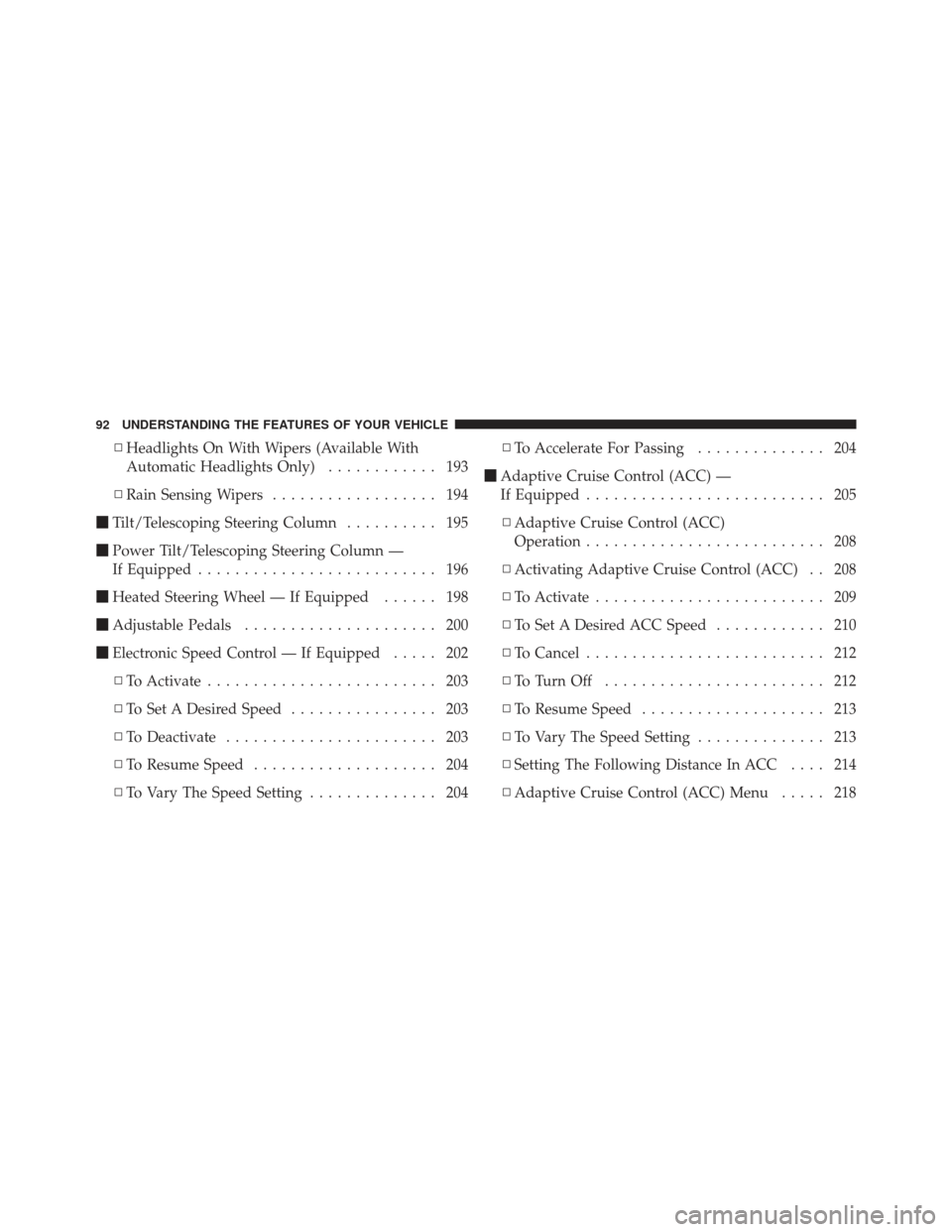
▫Headlights On With Wipers (Available With
Automatic Headlights Only) ............ 193
▫ Rain Sensing Wipers .................. 194
� Tilt/Telescoping Steering Column .......... 195
� Power Tilt/Telescoping Steering Column —
If Equipped .......................... 196
� Heated Steering Wheel — If Equipped ...... 198
� Adjustable Pedals ..................... 200
� Electronic Speed Control — If Equipped ..... 202
▫ To Activate ......................... 203
▫ To Set A Desired Speed ................ 203
▫ To Deactivate ....................... 203
▫ To Resume Speed .................... 204
▫ To Vary The Speed Setting .............. 204 ▫
To Accelerate For Passing .............. 204
� Adaptive Cruise Control (ACC) —
If Equipped .......................... 205
▫ Adaptive Cruise Control (ACC)
Operation .......................... 208
▫ Activating Adaptive Cruise Control (ACC) . . 208
▫ To Activate ......................... 209
▫ To Set A Desired ACC Speed ............ 210
▫ To Cancel .......................... 212
▫ ToTurnOff ........................ 212
▫ To Resume Speed .................... 213
▫ To Vary The Speed Setting .............. 213
▫ Setting The Following Distance In ACC .... 214
▫ Adaptive Cruise Control (ACC) Menu ..... 218
92 UNDERSTANDING THE FEATURES OF YOUR VEHICLE
Page 177 of 557
The memory seat switch is located on the driver ’s door
trim panel. The switch consists of three buttons: The (S)
button, which is used to activate the memory save
function and the (1) and (2) buttons which are used to
recall either of two pre-programmed memory profiles.Programming The Memory Feature
To create a new memory profile, perform the following:
1. Place the ignition into the RUN position.
2.
Adjust all memory profile settings to desired prefer-
ences (i.e., seat, side mirror, adjustable pedals [if equipped],
power tilt and telescopic steering column [if equipped],
and radio station presets).
3. Press and release the S (Set) button on the memory
switch.
4. Within five seconds, press and release either of the
memory buttons (1) or (2). The Electronic Vehicle Infor-
mation Center (EVIC) will display which memory posi-
tion has been set.
Memory Seat Switch
3
UNDERSTANDING THE FEATURES OF YOUR VEHICLE 175
Page 179 of 557
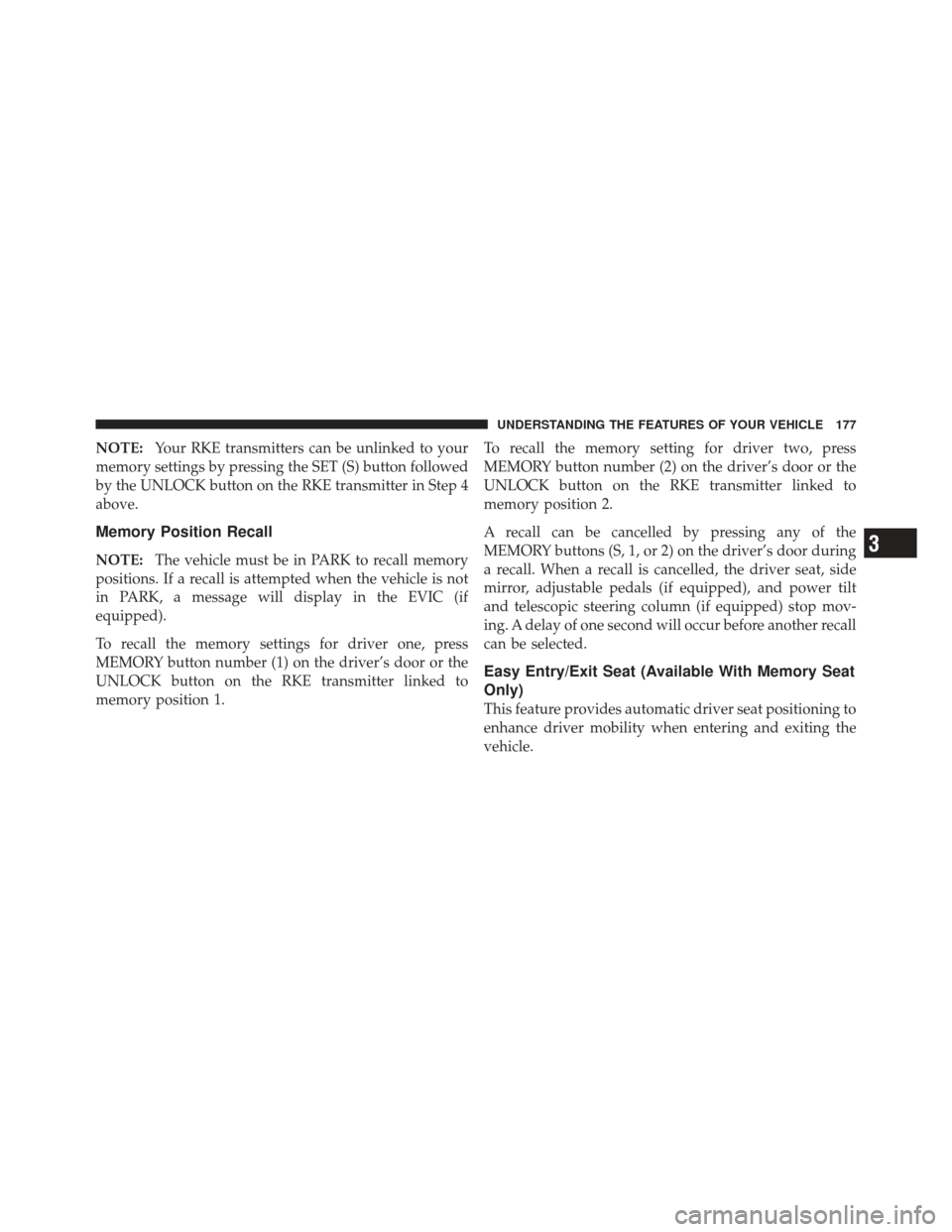
NOTE:Your RKE transmitters can be unlinked to your
memory settings by pressing the SET (S) button followed
by the UNLOCK button on the RKE transmitter in Step 4
above.
Memory Position Recall
NOTE: The vehicle must be in PARK to recall memory
positions. If a recall is attempted when the vehicle is not
in PARK, a message will display in the EVIC (if
equipped).
To recall the memory settings for driver one, press
MEMORY button number (1) on the driver’s door or the
UNLOCK button on the RKE transmitter linked to
memory position 1. To recall the memory setting for driver two, press
MEMORY button number (2) on the driver’s door or the
UNLOCK button on the RKE transmitter linked to
memory position 2.
A recall can be cancelled by pressing any of the
MEMORY buttons (S, 1, or 2) on the driver’s door during
a recall. When a recall is cancelled, the driver seat, side
mirror, adjustable pedals (if equipped), and power tilt
and telescopic steering column (if equipped) stop mov-
ing. A delay of one second will occur before another recall
can be selected.
Easy Entry/Exit Seat (Available With Memory Seat
Only)
This feature provides automatic driver seat positioning to
enhance driver mobility when entering and exiting the
vehicle.
3
UNDERSTANDING THE FEATURES OF YOUR VEHICLE 177
Page 198 of 557
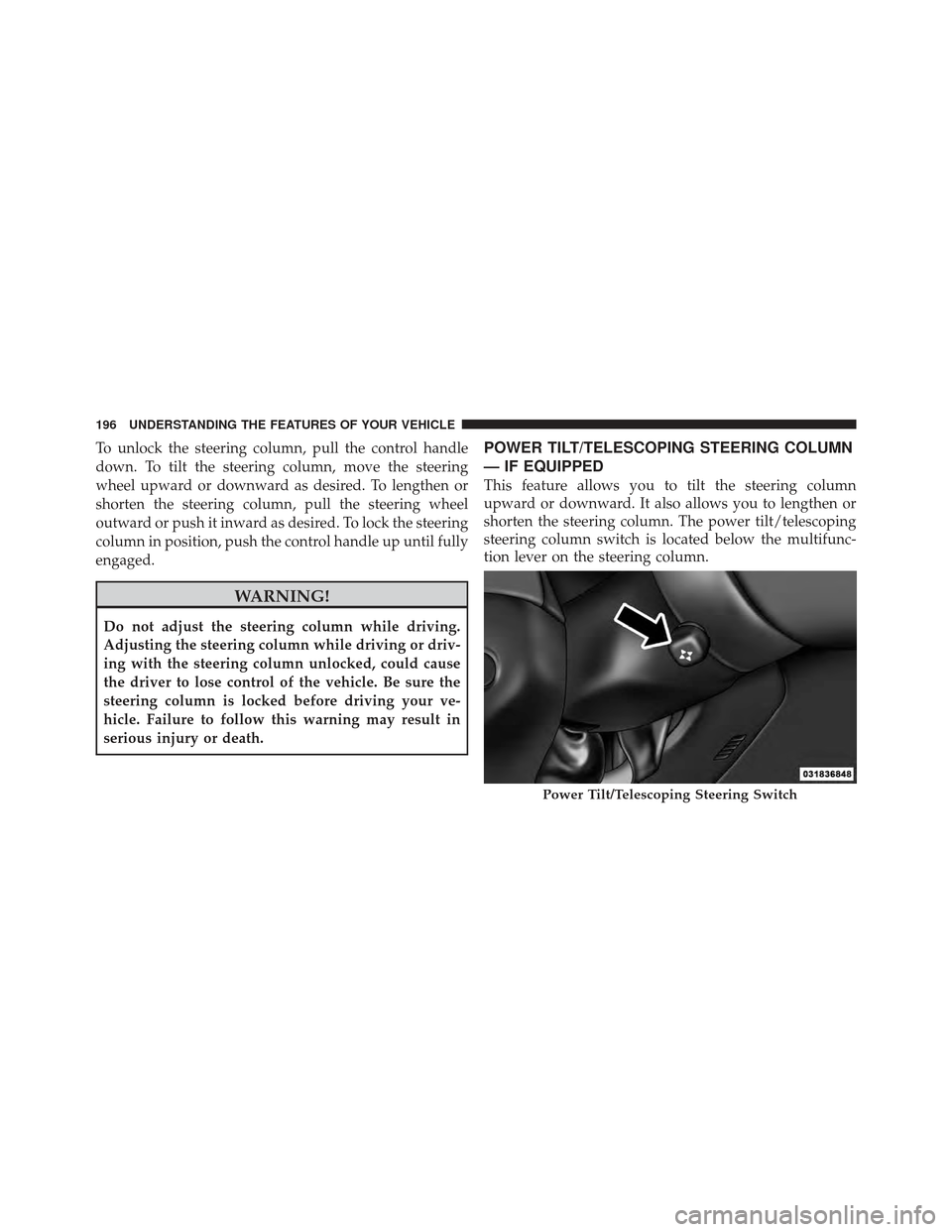
To unlock the steering column, pull the control handle
down. To tilt the steering column, move the steering
wheel upward or downward as desired. To lengthen or
shorten the steering column, pull the steering wheel
outward or push it inward as desired. To lock the steering
column in position, push the control handle up until fully
engaged.
WARNING!
Do not adjust the steering column while driving.
Adjusting the steering column while driving or driv-
ing with the steering column unlocked, could cause
the driver to lose control of the vehicle. Be sure the
steering column is locked before driving your ve-
hicle. Failure to follow this warning may result in
serious injury or death.
POWER TILT/TELESCOPING STEERING COLUMN
— IF EQUIPPED
This feature allows you to tilt the steering column
upward or downward. It also allows you to lengthen or
shorten the steering column. The power tilt/telescoping
steering column switch is located below the multifunc-
tion lever on the steering column.
Power Tilt/Telescoping Steering Switch
196 UNDERSTANDING THE FEATURES OF YOUR VEHICLE
Page 301 of 557
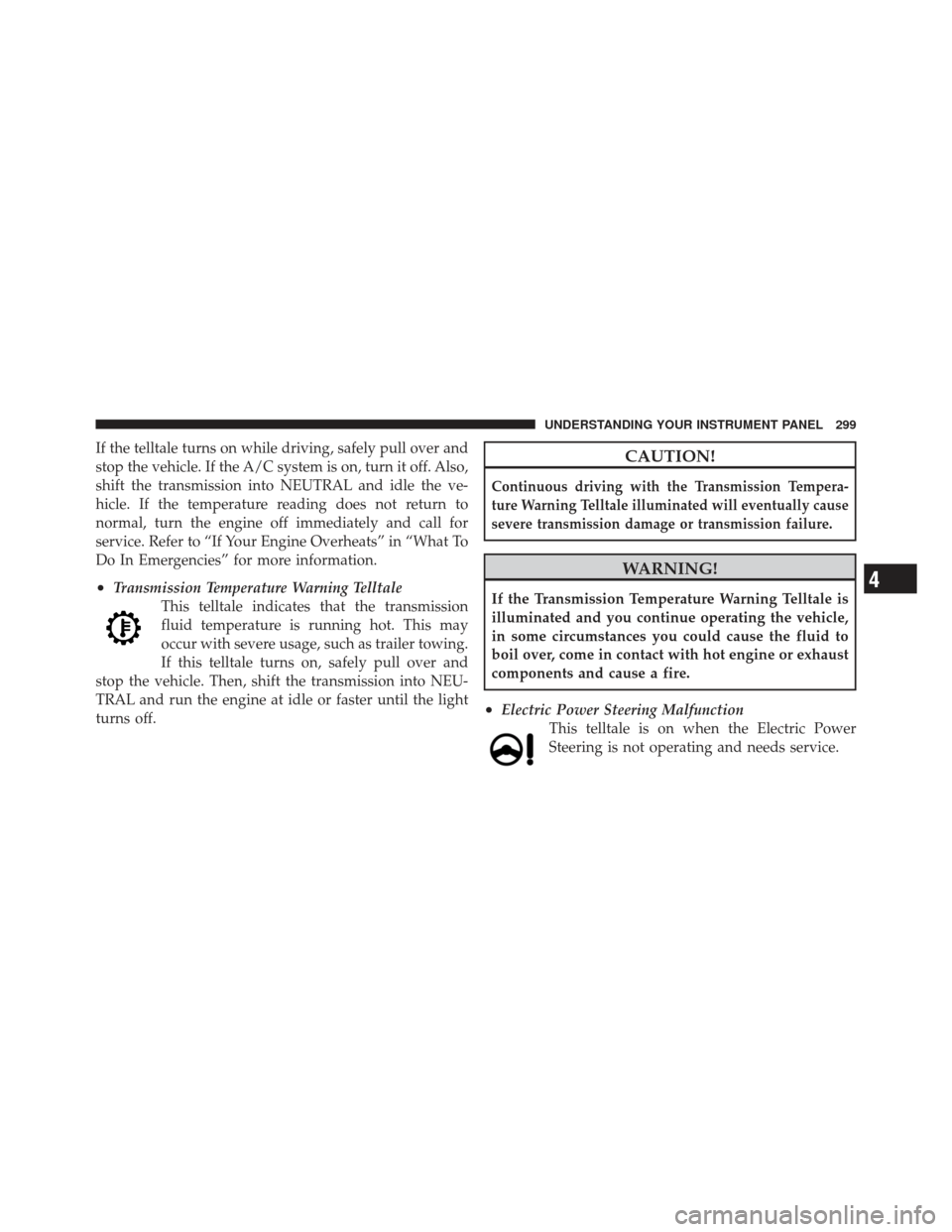
If the telltale turns on while driving, safely pull over and
stop the vehicle. If the A/C system is on, turn it off. Also,
shift the transmission into NEUTRAL and idle the ve-
hicle. If the temperature reading does not return to
normal, turn the engine off immediately and call for
service. Refer to “If Your Engine Overheats” in “What To
Do In Emergencies” for more information.
•Transmission Temperature Warning TelltaleThis telltale indicates that the transmission
fluid temperature is running hot. This may
occur with severe usage, such as trailer towing.
If this telltale turns on, safely pull over and
stop the vehicle. Then, shift the transmission into NEU-
TRAL and run the engine at idle or faster until the light
turns off.
CAUTION!
Continuous driving with the Transmission Tempera-
ture Warning Telltale illuminated will eventually cause
severe transmission damage or transmission failure.
WARNING!
If the Transmission Temperature Warning Telltale is
illuminated and you continue operating the vehicle,
in some circumstances you could cause the fluid to
boil over, come in contact with hot engine or exhaust
components and cause a fire.
•Electric Power Steering Malfunction This telltale is on when the Electric Power
Steering is not operating and needs service.
4
UNDERSTANDING YOUR INSTRUMENT PANEL 299
Page 329 of 557
•Battery Voltage
Shows the actual battery voltage.
Gauges 2
When selected, this screen displays the following values:
•Coolant Temperature
Shows the actual coolant temperature within the range of
the gauge.
•Oil Temperature
Shows the actual oil temperature within the range of the
gauge.
•Transmission Temperature
Shows the actual transmission temperature within the
range of the gauge.
•Intake Air Temperature
Shows the actual intake air temperature within the range
of the gauge.
•Oil Pressure
Shows the actual oil pressure.
•Battery Voltage
Shows the actual battery voltage.
Engine
When selected, this screen displays miles per hour (mph),
horsepower (hp), torque (ft/lb), oil pressure (psi) and
gear selector values.
Handling
When selected, this screen displays peak g-force, instan-
taneous g-force, steering and yaw angles.
Options
When selected, this screen allows you to choose a stan-
dard or custom display for your SRT home page.
4
UNDERSTANDING YOUR INSTRUMENT PANEL 327
Page 348 of 557
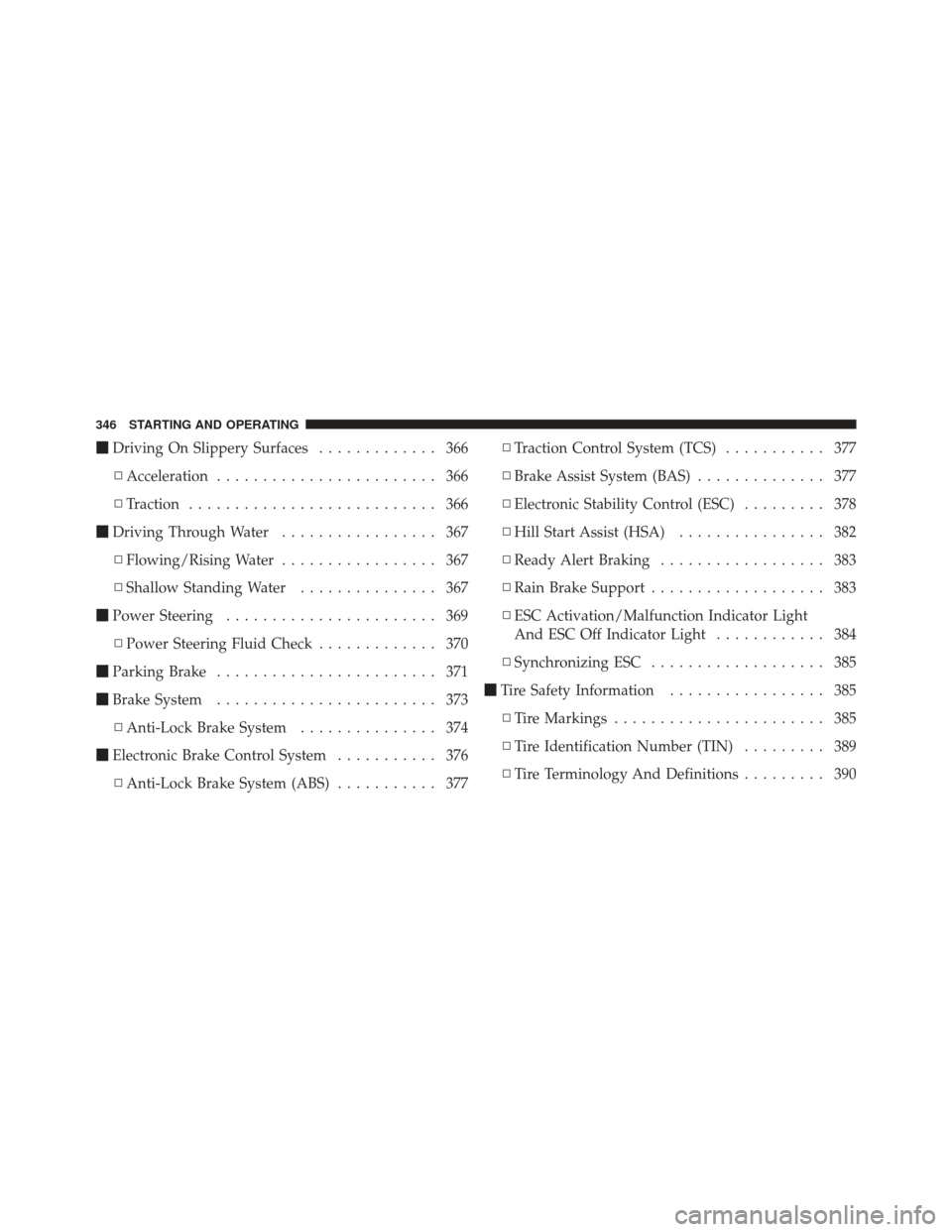
�Driving On Slippery Surfaces ............. 366
▫ Acceleration ........................ 366
▫ Traction ........................... 366
� Driving Through Water ................. 367
▫ Flowing/Rising Water ................. 367
▫ Shallow Standing Water ............... 367
� Power Steering ....................... 369
▫ Power Steering Fluid Check ............. 370
� Parking Brake ........................ 371
� Brake System ........................ 373
▫ Anti-Lock Brake System ............... 374
� Electronic Brake Control System ........... 376
▫ Anti-Lock Brake System (ABS) ........... 377▫
Traction Control System (TCS) ........... 377
▫ Brake Assist System (BAS) .............. 377
▫ Electronic Stability Control (ESC) ......... 378
▫ Hill Start Assist (HSA) ................ 382
▫ Ready Alert Braking .................. 383
▫ Rain Brake Support ................... 383
▫ ESC Activation/Malfunction Indicator Light
And ESC Off Indicator Light ............ 384
▫ Synchronizing ESC ................... 385
� Tire Safety Information ................. 385
▫ Tire Markings ....................... 385
▫ Tire Identification Number (TIN) ......... 389
▫ Tire Terminology And Definitions ......... 390
346 STARTING AND OPERATING